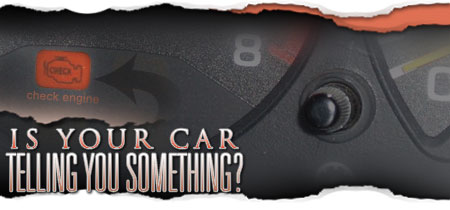
Ten Percent of Drivers Have Their "Check Engine" Light On
Some drives are using their vehicles without knowing of potentially hazardous engine problems. Ten percent of drivers in the United States who drive a car, light truck, SUV or minivan from model years 1981 to present are currently driving with their “check engine” light on, according to a survey conducted by CarMD.com. The survey also noted that half of those same drivers have had their “check engine” light on for more than three months — driving, in effect, oblivious to the potential problems indicated by the warning light.
"This study corroborates other industry reports that we have seen over the years, including those conducted by AutoZone and AAA," said Kristin Brocoff, marketing manager for CarMD.com. "With concerns about the environment and rising gas prices at all-time highs, it is a real cause for concern that so many drivers today ignore their vehicle's 'Check Engine' light."
Cost, denial and lack of time are some of the main reasons cited by survey respondents as to why they continue driving with their "Check Engine" lights illuminated. Over one-third said that they hadn't had their engine checked because their car appeared to be running fine and over one-tenth said they didn't believe there was a serious problem.
"It's quite alarming that fully half of the respondents who were driving with their "Check Engine" light on said their "Check Engine" light had been on for more than three months," Brocoff noted. "That indicates that a substantial number of people aren't as aware as they should be that their car may need immediate attention, or that they should take the time to ensure the safety and well-being of their vehicle."
The survey further noted that 20 percent of the respondents had been driving with their "Check Engine" light on for less than one week; 5 percent for 1-2 weeks; 8 percent for more than 2 weeks but less than 1 month; 10 percent for 1-2 months; and 7 percent for more than 2 months.
Of those currently driving with the "Check Engine" light (also known as malfunction indicator light or MIL) on, more than half exhibited some type of denial about the potential severity of the problem. Thirty-five percent said the reason they haven't had it checked is because "the car seems to be running fine." Another 16 percent said they didn't think [the problem was serious. Thirty-four percent of adults surveyed said cost is the reason they haven't had it checked — not surprising, given the current economic climate.
"It is disturbing to see these numbers," said Keith Andreasen, ASE double master technician and director of technical services for CarMD.com. "The U.S. government put the on-board diagnostic system in place to require vehicle manufacturers to alert drivers when their vehicle was emitting too many emissions or had a problem. This light can signify something potentially costly and possibly dangerous to the passengers or others on the road. It's important that drivers treat it seriously."
The survey also found the following facts about American drivers and their vehicle warning lights:
· Eighty-nine percent of U.S. adults indicate driving a primary vehicle model year 1981 or newer. Seventy-seven percent drive a car, light truck, SUV or minivan that is model year 1996 or newer. 10% of these model year 1996 and newer vehicles, which have OBD2 technology, also have a check engine light on currently.
· Younger adults (18-34) are more likely to indicate that they are driving with the light on (15% do, as compared to 11% of those aged 35-44, 9% of those aged 45-54 and 7% aged 55 or older).
· Time is also a factor, with 11% of respondents saying they "haven't had time" and 7% "waiting for an appointment with a mechanic" as reasons for not having their vehicle checked, despite the "Check Engine" light being on. A 31-year-old female who was surveyed said, "I know the light is on from an emissions leak. It's not impacting the way the car drives, and it will be time consuming to trace the leak and repair. There is never a good time to spend hours at a repair shop."
· Finding a mechanic or dealership you can trust is also a reason that drivers ignore their engine problems. Of those driving with illuminated MILs, 8 percent said they are "not sure where to go to have it checked" and another 7 percent said, "I don't have a mechanic I can trust."
· Even with gas prices hovering at $4 per gallon, many vehicle owners driving with the "check engine" light on don't seem to realize or believe gas mileage is likely affected by the problem. "It's just the gas cap," and "The car has been checked, a sensor is bad, but it causes the car to get better mileage," were two responses.
· Recurrent problems are also common. Several respondents have had the light on for over a year and had it looked at by several different mechanics. "[I've taken it to [the dealership 10+ times for this issue and they keep saying nothing is wrong per the diagnostic," answered a 45-year-old male.
For more information visit CarMD.com
*Survey and Sample Methodology
Harris Interactive® conducted the online omnibus survey on behalf of CarMD.com Corp., from May 20-22, 2008; among 2,041 U.S. adults aged 18+. Results were weighted as needed for region, age within gender, education, household income and race/ethnicity. Propensity score weighting was also used to adjust for respondents' propensity to be online. No estimates of theoretical sampling error can be calculated; a full methodology is available. For more information, please visit Harris Interactive. |